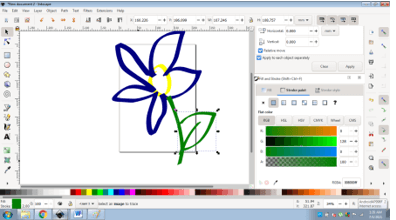

In Inkscape, we can import that PDF and 'explode' it so that we can manipulate its parts individually.

In this first exercise, we will take the plot we generated in Module 4's exercise on topic modeling in R where we made a bar chart showing the number of articles by year. No matter how deep you delve into these kinds of images, the image is always sharp - because the zoom is just another function of the mathematics describing the image. Vector images on the other hand are described by mathematical functions, of lines and arcs and areas. Raster images are composed of pixels, such that if you zoom into them, they become a pointilist blur (if you remember Ferris Beuller's Day Off, there's a scene where Cameron stares and stares at a painting, falling into its individual points of colour). The first thing to know is that graphic images come in two distinct flavours - raster and vector. Inkscape is also quite useful in that we can open a PDF file in it, break the visual elements of the PDF into individual layers, and then rearrange/touch up/fix them up to make them more esthetically appealing.
Inkscape change text color free#
A free program that is immensely useful in this regard is Inkscape. That way, we can add, rearrange, hide or reveal, our edits to create a composite image. We need a program that can deal with both, and also, lets us edit the image by treating each edit we do as a mostly-transparent layer on top of the image. A program like MS Paint is only useful for dealing with raster images (and then, only in certain kinds of cases). Sometimes, we would like to tweak these outputs to make them more visually appealling, or clearer, or more useful. After the text is converted to paths the font will no longer be referenced and the design will be defined by the shape of the original font.Some of the tools that we used in Module 4 give visual output as raster images, others as vectors. To convert the text to paths in Inkscape use the menu options “Path”-“Object to Path”. To avoid the possibility of the design changing when it is brought to a new computer you can convert the text to paths in Inkscape. This can dramatically change a design in some cases. The intended font may be swapped out for another font automatically. However if the font used in a design is not installed on the computer running K40 Whisperer. K40 Whisperer will convert text to paths for you when the design is loaded.

You can use the dialog that opens to create the text then change the stroke color to red/blue to engrave/cut.

To access the Hershey Text fonts in Inkscape go to “Extensions”-“Render”-“Hershey Text…”. There are a variety of stick fonts available in the Inkscape Extension for Hershey Text. If you don’t want to cut/engrave the outline of characters you will need to use a special font that consists of strokes not outlines, these fonts are commonly referred to as stick fonts. So if you want to vector cut/engrave a standard font you need to change the stroke color for the font, then you can vector cut/engrave the outline of the font. Text stroke color needs to be set in order to be interpreted as vector data.Īlthough text may look like strokes (depending on the font) generally standard fonts consist of outlines that are filled with a color. Text is a special kind of object usually defined by fill color. K40 Whisperer does not try to convert the filled portion of a shape to a vector path.ģ. Only the stroke colors are interpreted as vector cut/engrave features. Shapes/lines in SVG files have fill colors and stroke colors. Fill colors are not interpreted as vectors only the stroke colors for objects are converted to vector cut/engrave paths. The trace bitmap feature in Inkscape is located in the menu bar under “Path”-“Trace Bitmap”.Ģ. If you want to convert a raster image to vector engrave or cut paths you can use the bitmap trace feature in Inkscape to convert bitmap image to paths before sending the SVG file to K40 Whisperer. K40 Whisperer does not convert raster images to paths. If there is an image in the SVG file that contains blue or red the colors in the image are not recognized as a vector cut or engrave feature because the colored portion of an image is raster data not SVG path data. Blue and red colors in images are not converted to vectors. Here are a few of the common pitfalls that people encounter when reading SVG files into K40 Whisperer.ġ. A few people have experienced problems getting the red and blue lines to come into K40 Whisperer properly. In K40 Whisperer the red and blue vector paths in SVG files are converted to vector cut and vector engrave paths respectively.


 0 kommentar(er)
0 kommentar(er)
